Related Research Articles
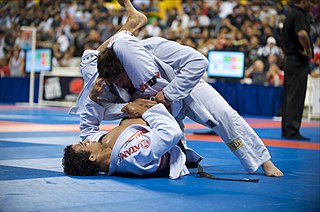
Brazilian jiu-jitsu, often abbreviated to BJJ, is a self-defense martial art and combat sport based on grappling, ground fighting, and submission holds. It is primarily a ground-based fighting style and focuses on taking one's opponent down to the ground, gaining a dominant position, and using a number of techniques to force them into submission via joint locks, chokeholds, or compression locks.
Vale Tudo or vale-tudo, also known as No Holds Barred (NHB) in the United States, is an unarmed, full-contact combat sport with relatively few rules. It became popular in Brazil during the 20th century and would eventually evolve into modern mixed martial arts (MMA). For years, "Vale Tudo" was used as a synonym for MMA in Brazil, but the term fell into disuse due to the emergence of stricter rules and the influence of the media to have a more "civilized" name. It is now used to refer to an early, more rules-free stage of the modern sport.
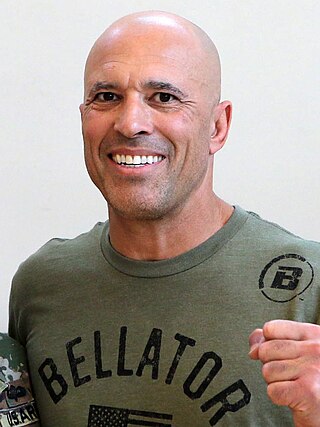
Royce Gracie is a Brazilian retired professional mixed martial artist. Gracie gained fame for his success in the Ultimate Fighting Championship (UFC). He is a member of the Gracie jiu-jitsu family, a UFC Hall of Famer, and is considered to be one of the most influential figures in the history of mixed martial arts (MMA). He also competed in PRIDE Fighting Championships, K-1's MMA events, and Bellator.

Renzo Gracie is a Brazilian mixed martial artist and 7th degree coral belt Brazilian jiu-jitsu practitioner and coach. A third generation member of the Gracie family, he is the grandson of Gracie jiu-jitsu co-founder Carlos Gracie, grandnephew of Helio Gracie, nephew of Carlos Gracie Jr. and the son of Robson Gracie.
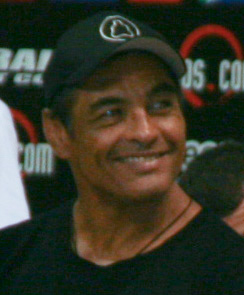
Rickson Gracie is a Brazilian retired mixed martial artist. He is a member of the Gracie family: the third oldest son of Hélio Gracie, brother to Rorion and Relson Gracie, and half-brother to Rolker, Royce, Robin and Royler Gracie. In the 1980s and 1990s, he was widely considered to be the best fighter of the Gracie clan, and one of the toughest in the world. In July 2017, he was promoted to ninth-degree red belt, the second-highest ranking in Brazilian jiu-jitsu.
Carlos Machado is a former world master's champion in Brazilian jiu-jitsu (BJJ) born in Rio de Janeiro, Brazil. He is the eldest of the five Machado Brothers, known for BJJ, that also includes Roger, Rigan, Jean Jacques and John. He is also the brother-in-law of UFC fighter Stephen Thompson. He currently runs BJJ schools across the United States, Australia, Canada and Mexico.

Marco Antônio de Lima Ruas is a Brazilian former mixed martial arts fighter, submission wrestler, kickboxer and instructor. Ruas was the UFC 7 Tournament Champion, and also competed for the World Vale Tudo Championship (WVC), PRIDE Fighting Championships and the International Fight League, where he head-coached the Southern California Condors.
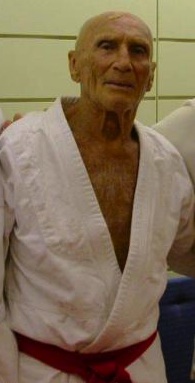
Hélio Gracie was a Brazilian martial artist who together with his brothers Oswaldo, Gastao Jr, George and Carlos Gracie founded and developed the self-defense martial art system of Gracie jiu-jitsu, also known as Brazilian jiu-jitsu (BJJ).

Royler Gracie is a Brazilian-American retired mixed martial artist and Brazilian jiu-jitsu practitioner. Gracie ran the Gracie Humaitá school in Rio de Janeiro for many years under his father Helio's direction, and lives and teaches in San Diego, California. Considered a legend of jiu jitsu and submission wrestling, Gracie is a member of both the IBJJF Hall of Fame, and the ADCC Hall of Fame.

Carlson Gracie was a practitioner of Brazilian jiu-jitsu. A member of the Gracie family, he was the eldest son of Carlos Gracie, and nephew to Hélio Gracie, founders of Gracie jiu-jitsu.
The Gracie Challenge was an open invitation challenge match issued by members of the Gracie family, representing their self-defense system of Gracie Jiu-Jitsu against challengers of other martial art systems in a vale tudo match, or "anything goes" competition.

Rorion Gracie is a Brazilian-born Gracie Jiu-Jitsu Grand Master, a prominent member of the Gracie family, writer, publisher, producer, lecturer, lawyer and the co-founder of the Ultimate Fighting Championship. He is the oldest son of Hélio Gracie and one of the few people in the world to hold a 9th degree red belt in Brazilian Jiu-Jitsu, and is widely recognized as one of the men responsible for introducing Gracie/Brazilian Jiu-Jitsu to the United States and the world.
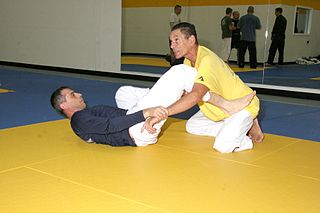
The Gracie family is a family of martial artists originally from Belém, state of Pará, Brazil, whose ancestors came from Paisley, Scotland. They are known for promoting the self-defense martial arts system of Gracie Jiu-Jitsu, commonly known as Brazilian jiu-jitsu, originating from Kano jiu-jitsu (Judo) brought to Brazil by judoka prizefighter Mitsuyo Maeda.
Jean Jacques Machado is a Brazilian Jiu jitsu practitioner. He is one of the five Machado brothers. Machado is nephew of BJJ co-founder and Grandmaster Carlos Gracie, and learned the martial art from an early age.
Saulo Mendonça Ribeiro Filho is a Brazilian submission grappler and former mixed martial artist. He is a 6th-degree black belt in Brazilian jiu-jitsu (BJJ) and brother of Xande Ribeiro. After earning a black belt in judo, he began his training of Brazilian jiu-jitsu in Rio de Janeiro under Royler Gracie, the son of Hélio Gracie, at Gracie Humaitá.
The Machado Family are a family of Brazilian jiu-jitsu practitioners, mixed martial artists and grapplers. They are the founders of RCJ Machado Brazilian Jiu-Jitsu and are cousins to members of the Gracie family.
Kron Stavik Gracie is a Brazilian and American mixed martial artist, submission grappler, and instructor. He currently competes in the Featherweight division of the Ultimate Fighting Championship.
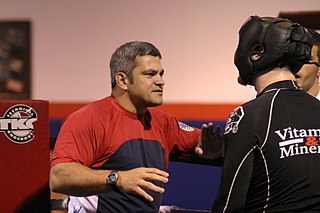
Antonio Ricardo Jardim Libório is a Brazilian jiu jitsu black belt under Grand Master Carlson Gracie. He is the co-founder of American Top Team (ATT) and Brazilian Top Team (BTT), the founder and CEO of Martial Arts Nation and the International Brazilian Jiu-Jitsu Institute (IBJJI), and also a professor of BJJ at the University of Central Florida.
The fight between Japanese judoka Masahiko Kimura and Brazilian jiu-jitsu founder Hélio Gracie was held at the Maracanã Stadium in Rio de Janeiro on October 23, 1951. It was held as a special challenge, with no titles on the line: Gracie was the self-proclaimed national jiu-jitsu champion, seen as a regular judo 6th dan by Kimura, while Kimura himself was coming from a career in professional wrestling and teaching of judo. The result of the fight was a victory for Kimura by technical submission.
References
- ↑ Gracie, Helio; Soto, Thomas D.E. (29 November 2012). Gracie Jiu-Jitsu. Saraiva Editora. ISBN 978-85-02-06184-2.
- ↑ "Gracie Jiu-Jitsu Primeira Edição". Mundo Positivo. Retrieved 4 January 2012.[ permanent dead link ]
- ↑ "Escola de Jiu-Jitsu Brasileiro Azambuja, Jiu-jitsu de A a Z, Formando Cidadãos". Escola Azambuja. Archived from the original on 17 March 2012. Retrieved 15 March 2012.